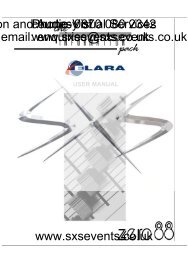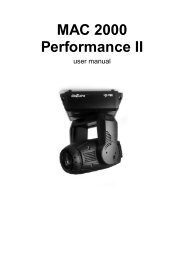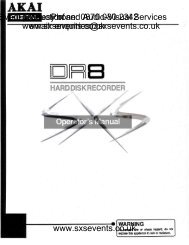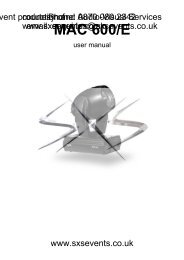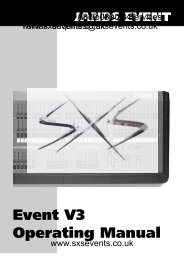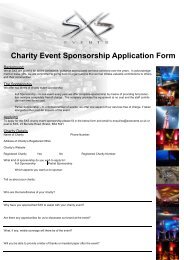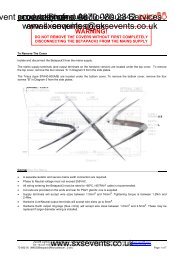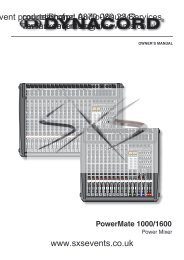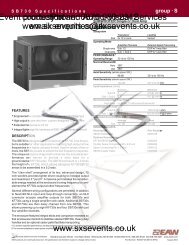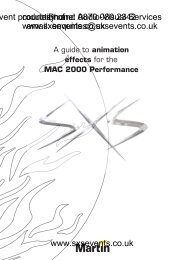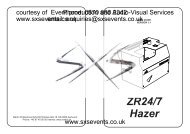Rigging - CM Lodestar Manual - SXS Events
Rigging - CM Lodestar Manual - SXS Events
Rigging - CM Lodestar Manual - SXS Events
You also want an ePaper? Increase the reach of your titles
YUMPU automatically turns print PDFs into web optimized ePapers that Google loves.
SAFETY PRECAUTIONS<br />
Each Entertainment-<strong>Lodestar</strong> Electric Hoist is built in accordance with the specifications contained herein and at the time of<br />
manufacture complied with our interpretation of applicable sections of the *American Society of Mechanical Engineers Code<br />
vent courtesy production Phone: of and 0870 Audio-Visual 080 2342Services<br />
www.sxsevents.co.uk<br />
B30.16 “Overhead Hoists”, the National Electrical Code (ANSI/NFPA 70), the Occupational Safety and Health Act, British Health<br />
Safety Executives, TUV and CE Directive. Since OSHA states the National Electrical Code applies to all electric hoists,<br />
installers are required to provide current overload protection and grounding on the branch circuit section in keeping with the<br />
code.<br />
email:<br />
Check each installation<br />
enquiries@sxsevents.co.uk<br />
for compliance with the application, operation and maintenance sections of these articles.<br />
The safety laws for elevators, lifting of people and for dumbwaiters specify construction details that are not incorporated in <strong>CM</strong><br />
industrial hoists. For such applications, refer to the requirements of applicable state and local codes, and the American<br />
National Safety Code for elevators, dumbwaiters, escalators and moving walks (ASME A17.1). Columbus McKinnon<br />
Corporation cannot be responsible for applications other than those for which <strong>CM</strong> equipment is intended.<br />
*Copies of this Standard can be obtained from ASME Order Department, 22 Law Drive, Box 2300, Fairfield, NJ 07007-2300,<br />
U.S.A.<br />
V<br />
LODESTAR<br />
! !<br />
THIS SYMBOL POINTS OUT IMPORTANT SAFETY INSTRUCTIONS WHICH IF NOT FOL-<br />
LOWED COULD ENDANGER THE PERSONAL SAFETY AND/OR PROPERTY OF YOUR-<br />
SELF AND OTHERS. READ AND FOLLOW ALL INSTRUCTIONS IN THIS MANUAL AND<br />
ANY PROVIDED WITH THE EQUIPMENT BEFORE ATTEMPTING TO OPERATE YOUR<br />
HOIST.<br />
WARNING<br />
Usage of hoists that do not involve lifting of the load on<br />
the lower hook or using hoists in the inverted position<br />
without special precaution may cause an accident<br />
resulting in injury and/or property damage.<br />
V!<br />
WARNING<br />
Improper operation of a hoist can create a potentially<br />
hazardous situation which, if not avoided, could result<br />
in death or serious injury. To avoid such a potentially<br />
hazardous situation, the operator shall:<br />
1. NOT lift people.<br />
2. NOT allow people on unsecured load without fall protection.<br />
3. NOT exceed rated capacity of hoist.<br />
4. NOT remove or obscure any capacity or warning label.<br />
5. Check the supporting structure. The connection between the<br />
load hook and structure. The load itself and the connection between<br />
the hoist support and the load for their ability to withstand the loads<br />
imposed with an adequate design factor.<br />
6. Tie off the load with auxiliary chains or cables before access to<br />
the area beneath the load is permitted. As an alternative, the<br />
system may be designed such that malfunction or failure of one<br />
hoist’s load bearing components does not cause load loss and/or<br />
overloading of any other hoists in the system. Note that in such a<br />
system, hoist performance and function must be monitored visually<br />
or with use of load cells.<br />
7. Read hoist manual and special instructions before installing and<br />
operating the hoist.<br />
V!<br />
V!<br />
CAUTION<br />
Successful Theatrical Hoist Operation Requires the following actions:<br />
At the loose end, maintain a minimum of 24 inches of chain freely<br />
hanging over the side of hoist.<br />
Keep load chain well lubricated using Lubriplate ® 10R Bar and<br />
Chain oil.<br />
Do make sure hoist is phased properly and chain travel limits<br />
function properly.<br />
If a chain container is used, inspect before each use for damaged,<br />
loose hardware and water drainage provisions. Make certain container<br />
attachment hardware has an adequate design factor of a minimum of<br />
5 to 1. Also, make sure chain container is of sufficient capacity: chain<br />
chain in fully loaded container shall not exceed 75% of container<br />
height.<br />
V!<br />
www.sxsevents.co.uk<br />
CAUTION<br />
! V!<br />
Improper operation of a hoist can create a potentially<br />
hazardous situation which, if not avoided, could result<br />
in minor or moderate injury. To avoid such a potentially<br />
hazardous situation, the operator shall:<br />
1. Maintain a firm footing or be otherwise secured when operating<br />
the hoist.<br />
2. Check brake function by tensioning the hoist prior to each lift<br />
operation.<br />
3. Use hook latches. Latches are to retain slings, chains, etc. under<br />
slack conditions only.<br />
4. Make sure the hook latches are closed and not supporting any<br />
parts of the load.<br />
5. Make sure the load is free to move and will clear all obstructions.<br />
6. Avoid swinging the load or hook.<br />
7. Make sure hook travel is in the same direction as shown on the<br />
controls.<br />
8. Inspect the hoist regularly, replace damaged or worn parts, and<br />
keep appropriate records of maintenance.<br />
9. Use <strong>CM</strong> parts when repairing the unit.<br />
10. Lubricate load chain per instructions in this manual.<br />
11. NOT use the hoist load limiting or warning device to measure load.<br />
12. NOT use limit switches as routine operating stops. They are<br />
emergency devices only.<br />
13. NOT allow your attention to be diverted when operating hoist.<br />
14. NOT allow the hoist to be subjected to sharp contact with other<br />
hoists, structures, or objects through misuse.<br />
15. NOT adjust or repair the hoist unless qualified to perform such<br />
adjustments or repairs.<br />
ii



